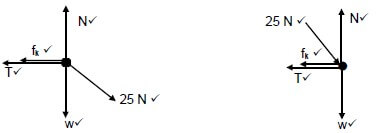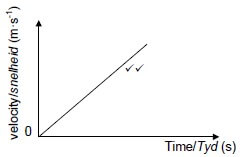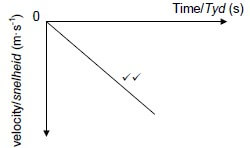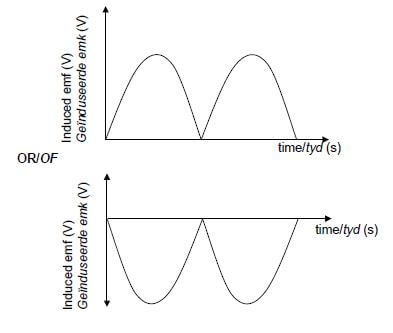PHYSICAL SCIENCES PHYSICS PAPER 1 GRADE 12 MEMORANDUM - NSC PAST PAPERS AND MEMOS NOVEMBER 2016
Share via Whatsapp Join our WhatsApp Group Join our Telegram GroupPHYSICAL SCIENCES
PHYSICS PAPER 1
GRADE 12
NSC EXAM PAPERS AND MEMOS
NOVEMBER 2016
MEMORANDUM
1.1 A ✓✓ (2)
1.2 C ✓✓ (2)
1.3 C ✓✓ (2)
1.4 D ✓✓ (2)
1.5 B ✓✓ (2)
1.6 A ✓✓ (2)
1.7 C ✓✓ (2)
1.8 A ✓✓ (2)
1.9 B ✓✓ (2)
1.10 B ✓✓ (2) [20]
QUESTION 2
2.1 When a resultant/net force acts on an object, the object will accelerate in the (direction of the net/resultant force). The acceleration is directly proportional to the net force ✔and inversely proportional to the mass ✔of the object.
OR
The resultant/net force acting on the object is equal (is directly proportional to) to the rate of change of momentum of an object (in the direction of the force). ✔✔ (2)
2.2 (3)
fk = μkN✔= μkmg |
2.3 
Accepted Labels | |
w | Fg/Fw/force of Earth on block/weight/14,7 N/mg/gravitational force |
N | FN/Fnormal/normal force |
T | Tension/FT |
fk | fkinetic friction/ff/w/f//Ff/wkinetic frictiong |
25 N | Fapplied/FA/F |
2.4.1 (3)
OPTION 1 fk = μkN = μk(25sin 30º + mg) | OPTION 2 fk = μkN = μk(25cos 60º + mg) |
2.4.2
POSITIVE MARKING FROM QUESTION 2.2 AND QUESTION 2.4.1 |
OPTION 2 | OPTION 3 |
(5)
[18]
QUESTION 3
3.1 The motion of an object under the influence of gravity/weight/gravitational force only / Motion in which the only force acting is the gravitational force.✔✔ (2)
OPTION 1 | OPTION 2 |
OPTION 3 |
OPTION 4 |
OPTION 5 |
(4)
3.2.2
POSITIVE MARKING FROM QUESTION 3.2.1 Upwards positive |
OPTION 2 | Downwards Positive |
OPTION 3 Upwards positive: Δy = [ v1 + vf] Δt | |
(3)
3.3
Downward positive
Upward positive
Notes
✔✔ | Straight line through the origin. |
(2)
[11]
QUESTION 4
4.1 A system on which the resultant/net external force is zero✔ A system which excludes external forces (1)
4.2.1 (3)
OPTION 1 |
OPTION 2 |
4.2.2 POSITIVE MARKING FROM QUESTION 4.2.1
OPTION 1 ∑pi = ∑pf |
OPTION 2 |
(5)
4.2.3
OPTION 1 |
OPTION 2 |
POSITIVE MARKING FROM QUESTION 4.2.2 |
OPTION 4 | |
Fnet = m(vf - vi) ✔ 1500(9,33 − 20)✔ | vf = vi + aΔt |
(4)
[13]
QUESTION 5
5.1.1 Ek/K = ½ mv2 ✔
= ½ (2)(4,95)2 ✔
= 24,50 J ✔ (3)
5.1.2 (4)
POSITIVE MARKING FROM QUESTION 5.1.1 | |
OPTION 2 | OPTION 3 |
OPTION 4 | |
5.2 The net/total work done on an object is equal ✔to the change in the object's kinetic energy ✔
OR
The work done on an object by a resultant/net force is equal to the change in the object's kinetic energy. (2)
5.3
OPTION 1 |
OPTION 2 |
(4)
[13]
QUESTION 6
6.1
6.1.1 It is the (apparent) change in frequency (or pitch) of the sound (detected by a listener) ✔ because the sound source and the listener have different velocities relative to the medium of sound propagation. ✔
OR
An (apparent) change in (observed/detected) frequency (pitch), (wavelength) ✓as a result of the relative motion between a source and an observer ✓(listener). (2)
6.1.2
v = fλ ✔
340 = f(0,28) ✔
fs = 1 214,29 Hz ✔ (3)
6.1.3 POSITIVE MARKING FROM QUESTION 6.1.2
fL = v ± vL fs OR fL = v ± vL × v OR fL = v fs OR FL = fs
v ± vs v ± vs λs v - vs 1 - vs/v
fL = 340 1214,29 OR fL = 340 × 340 OR FL = 1214,29
(340 - 30) (340 - 30) 0,28 1 - 30/340
= 1 331,80 Hz✔ (1 331,80 Hz – 1 335,72 Hz) (5)
6.1.4 Decreases ✔ (1)
6.2 The spectral lines of the star are/should be shifted towards the lower frequency ✔ end, which is the red end (red shift) of the spectrum. ✔
(2)
[13]
QUESTION 7
7.1.1 The (magnitude of the) electrostatic force exerted by one (point) charge on another is directly proportional to the product of the charges ✓ and inversely proportional to the square of the distance between their (centres) them. ✓ (2)
7.1.2 FE/Electrostatic force✓ (1)
7.1.3 The electrostatic force is inversely proportional to the square of the distance between the charges ✔
OR
The electrostatic force is directly proportional to the inverse of the square of the distance between the charged spheres (charges). ✔
OR
F α 1 ✔
r2
OR
They are inversely proportional to each other (1)
7.1.4 (6)
OPTION 1 Examples ( 0,005) ✔ = (9 × 109) Q2 ✔ (0,027 ) ✔ = (9 × 109) Q2 ✔ Q = 7,32 x 10-7 C ✔ |
7.2.1
Criteria for drawing electric field: | Marks |
Direction | ✓ |
Field lines radially inward | ✓ |
7.2.2
E = kQ
r2
Take right as positive
EPA = (9 × 109) (0,75 ×10-6) ✔
(0,09)2
= 8,33 x 105 N∙C-1 to the left
EPB = (9 × 109) (0,8 ×10-6) ✔
(0,03)2
= 8 x 106 N∙C-1 to the left
Enet = EPA + EPC
= [-8,33 x 105 + (- 8 x 106)] ✔
= -8,83 x 106
= 8,83 x 106 N∙C-1✔
1 mark for the addition of same signs
Take left as positive
EPA = (9 × 109) (0,75 ×10-6) ✔
(0,09)2
= 8,33 x 105 N∙C-1 to the left
EPB = (9 × 109) (0,8 ×10-6) ✔
(0,03)2
= 8 x 106 N∙C-1 to the left
Enet = EPA + EPC
= (8,33 x 105 + 8 x 106) ✔
1 mark for the addition of same signs
= 8,83 x 106 N∙C-1 ✔
(5)
[17]
QUESTION 8
8.1.1 (Maximum) energy provided (work done) by a battery per coulomb/unit charge passing through it ✔✔ (2)
8.1.2 12 (V)✔ (1)
8.1.3 0 (V) / Zero✔ (1)
8.1.4
ε = I(R + r)
ε = Vext + Vint
12 = 11,7 +Ir
0,3 = Itot(0,2) ✔
Itot = 1,5 A ✔
OR
V = IR ✔ (Accept: V”lost” = Ir)
0,3 = Itot(0,2) ✔
Itot = 1,5 A✔ (3)
OPTION 1 | OPTION 2 R|| = R1R2 (2) |
POSITIVE MARKING FROM QUESTIONS 8.1.4 AND 8.1.5 |
OPTION 2 |
OPTION 3 (4) |
8.2.1 (3)
Pave= Fvave✔= mg(vave) |
8.2.2
POSITIVE MARKING FROM QUESTION 8.2.1 | |
OPTION 1 | OPTION 2 |
OPTION 3 Ptot = Pr + Pmotor + PT |
OPTION 4 ✔Any one ε = I(R + r) | ||
V = IR | P = I2R | Pmotor = V2 = 19,31 Ω ✔ |
(5)
[21]
QUESTION 9
9.1.1 DC/GS-generator✔
Uses split ring/commutator✔ (2)
9.1.2 
9.2.1
OPTION 1 | OR |
9.2.2
OPTION 2 EITHER: (3) |
POSITIVE MARKING FROM QUESTION 9.2.1 |
OPTION 2 2000 = 3402 |
OPTION 3 |
OPTION 4 |
OPTION 5 IT : IK |
(4)
[11]
QUESTION 10
10.1
10.1.1 The minimum frequency (of a photon/light) needed✓ to emit electrons from (the surface of) a metal. (substance) ✓
OR
The frequency (of a photon/light) needed✓ to emit electrons from (the surface of) a metal. (substance) with zero kinetic energy✓ (2)
10.1.2 Silver/Silwer✔
Threshold/cutoff frequency (of Ag) is higher✔
Wo α fo / Wo = hfo ✔
OR
To eject electrons with the same kinetic energy from each metal, light of a higher frequency/energy is required for silver. ✓ Since E = Wo + Ek(max) (and Ek is constant), the higher the frequency/energy of the photon/light required, the greater is the work function/Wo.✓ (3)
10.1.3 Planck’s constant ✔ (1)
10.1.4 Sodium✔ (1)
10.2
10.2.1 Energy radiated per second by the blue light
= (5/100)(60 x 10-3) ✔ = 3 x 10-3 J∙s-1
Ephoton = hc ✔
λ
= (6,63 × 10-34 )(3 × 108)
470 × 10-9
= 4,232 x 10-19J ✔
Total number of photons incident per second
= 3 × 10-3
4,232 × 1015
= 7,09 x 1015 ✔ (5)
10.2.2 POSITIVE MARKING FROM QUESTION 10.2.1
7,09 x 1015 (electrons per second) ✔
OR
Same number as that calculated in Question 10.2.1 above (1)
[13]
TOTAL: 150